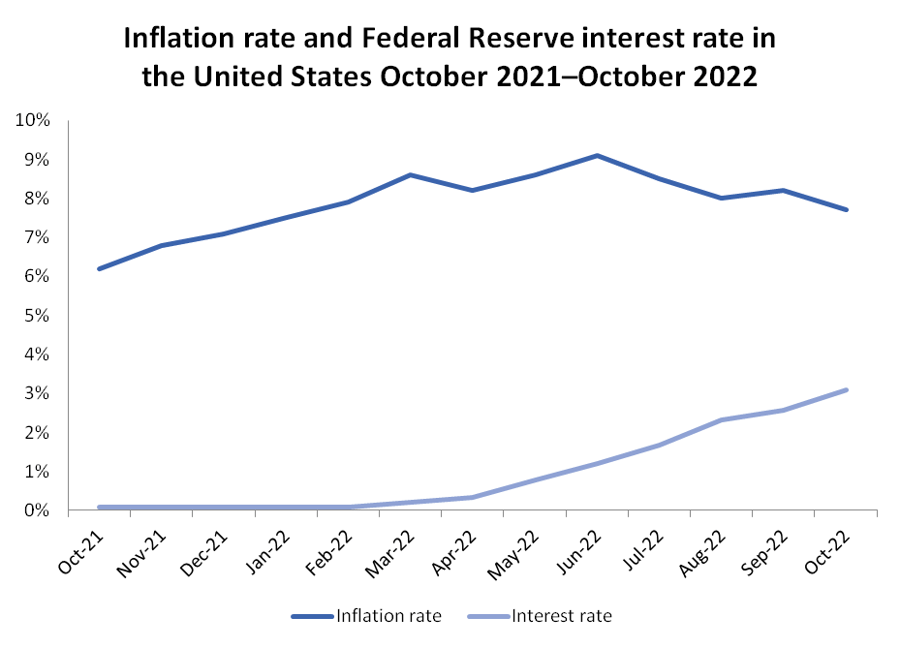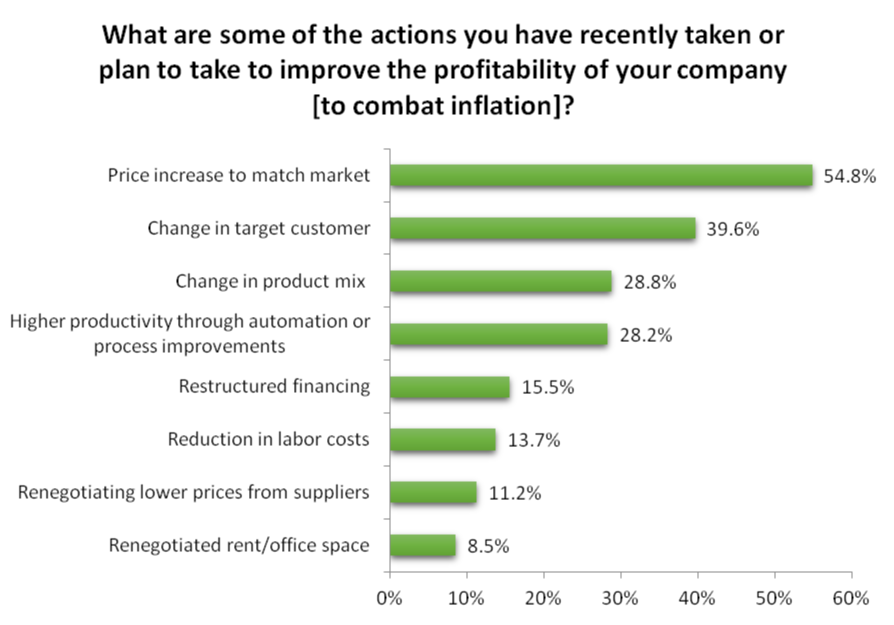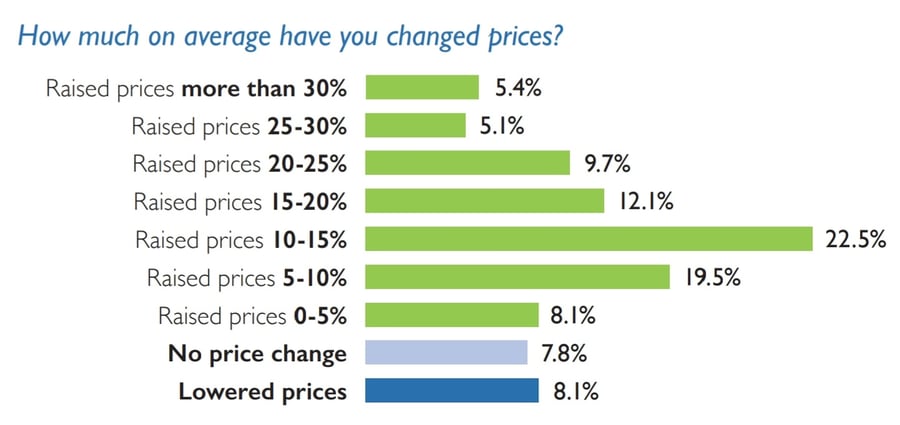
Inflation is a standard economic process. But runaway inflation leads to steep price increases for businesses and their customers.
Most countries are currently grappling with a high rate of inflation, which is caused by global factors, including the pandemic, supply chain disruptions, and ongoing conflict.
Experts expect these higher prices to continue for a couple of years, so businesses need to prepare. We’ve created this guide on how to prepare for inflation to help you reduce its impacts and make your eCommerce business more resilient to future economic shocks.
Challenges of Inflation for eCommerce Businesses
High inflation hits consumers in their pockets, leaving them with higher bills and less disposable income. Inflation also presents several challenges for eCommerce businesses, which include the following.
Higher Costs
Inflation means paying more for raw materials and products, increasing your cost of goods sold (COGS). The cost of carrying inventory is also rising, as are shipping costs and the price of utilities like electricity and gas. These extra expenses are creating cash flow problems, particularly for small businesses.
Supply Chain Disruption
The supply chain disruptions that began in early 2020 have continued into 2023. Rising inflation is making it worse by reducing businesses' purchasing power and inventory levels. Businesses have to wait longer for stock to become available, and when it does, they face higher shipping costs and longer delivery times.
Labor and Supply Shortages
Businesses are also facing a shortage of labor and supplies. Supply shortages mean delays and higher prices, which you may have to pass on to customers.
Unemployment is also low, particularly in countries like the US and UK, so it’s hard for businesses to hire new staff. Businesses must raise wages or rely on expensive temp workers, further eating into their profit margins.

Source: The White House
Higher Prices for Consumers
Higher costs mean many businesses are raising their prices to compensate, which can put customers off. Now, more than ever, customers are looking for the lowest-cost goods. So, they may look elsewhere if you raise your prices too steeply.
Tighter Profit Margins
If you don’t increase your prices, it will squeeze your profit margins, so your business may not be viable long-term. Also, since inflation decreases a currency’s value, your profit also decreases 一 as does the value of your business.
Lower Consumer Spending
Many consumers are reducing their spending to try to save money. That means buying fewer non-essential items, which is a problem for many eCommerce businesses.
Also, larger retailers can often keep their prices lower than small businesses. This attracts consumers away from small businesses in favor of large eCommerce sites like Amazon.
Higher Taxes and Tariffs
If you source your raw materials or products from overseas or ship to international customers, you have to pay tariffs. This further increases the cost of raw materials and finished goods. Also, if the government raises taxes to try to combat inflation, this will reduce demand even more.
Higher Interest Rates
To try to curb inflation, the Federal Reserve and the Bank of England have raised interest rates. In fact, it's a similar situation around the world. This means greater borrowing costs for businesses. You’ll also have to pay back more on any outstanding debts you have.
Business loans are also harder to get, with approval rates around half that of pre-2020 levels. This is partly because inflation means small businesses are worth less than they were, so they're riskier investments.

Data Source: Statista
Market Uncertainty
Most experts agree that high inflation will last well into next year, although predictions vary by country. Of course, exact predictions are impossible to make, which creates market uncertainty. All you can do is put plans in place for different outcomes and prepare your business for inflation 一 which leads us to our next point.
10 Ways to Prepare Your Business for Inflation
As a business owner, there are lots of things you can do to lessen the impacts of inflation. Here are ten steps you can take to increase your business’s resiliency.
1. Automate and digitize your processes.
Automating your business processes is one way to combat the effects of inflation. Automation reduces the amount of labor needed to run your business and leaves you and your employees free to focus on higher-value tasks.
For example, investing in software to automate the tax filing process can save you and your accountants a lot of time. Plus, if you run a business in the UK, making tax digital also ensures you meet the latest HMRC requirements. After all, the last thing you need in a time of high inflation is to fall foul of the IRS or HMRC.
Bear in mind that the goal of automation isn’t to replace your workforce, but to help your employees simplify their workflows and boost productivity. This benefits them and your business, allowing you to stay competitive in the current economic climate.
2. Diversify your supply chain.
A lean supply chain is great for keeping your costs down, but it’s also more vulnerable to rises in inflation. To lessen the impact on your business, you need to make your supply chain more resilient. One way to do this is to understand and diversify your supply chain. Areas to focus on include:
- Suppliers: Strengthen your relationships with current suppliers. Also, try to find local backup suppliers to reduce the impact of shortages or delays.
- Production: Understand the impact of supply shortages on the production of your most profitable SKUs. Put plans in place to deal with them.
- Warehousing: Find a third-party logistics provider in case one of your warehouses goes down or you need to increase production.
- Inventory: Understand how much of each type of inventory you have and where. This includes finished and unfinished items.
- Customer Service: Maintain clear communication channels with customers. Keep them informed of delays and other issues with their orders.

Source: FinancesOnline
3. Perform targeted spending cuts.
Spending cuts are one option for combating the effects of higher prices. Avoid generic, across-the-board cuts but perform targeted cuts that won’t affect growth. Below are some do’s and don’ts for cutting your spending.
Do:
- Identify areas of inefficiency. For example, there may be redundant processes or positions you can scrap.
- Cut initiatives that aren’t delivering good value for money.
- Be transparent with your employees if you need to cut pay or benefits or bring in redundancies.
- Think about the future. For example, will you need a large office, or can employees work remotely?
Don’t:
- Cut strong talent or areas of positive cash flow, such as SEO or advertising.
- Stop marketing. Instead, try to find inexpensive ways to market your business, like social media and email marketing.
- Stop investing in new technology. The future is digital, after all.
- Overlook smaller expenses like office supplies, furniture, and snacks. They all add up in cost.
4. Use 'what if' scenarios to stay flexible.
Your business plans 一 both short-term and long-term 一 need to be flexible. That way, you can quickly adapt to inflation and changes to IRS or HMRC policies.
To plan effectively, run ‘what if’ scenarios with your financial forecasts to test different impacts of inflation. For instance, you could run scenarios for wage increases, increases in the price of raw materials, and supply chain disruptions. For each scenario, ask questions like:
- How will this affect your cash flow?
- How can you lessen the impact of this scenario?
- Can you take preventative steps now to lower your risk?
- Which indicators can you use to track the situation?
5. Focus on profitability and efficiency.
Inflation makes it hard to grow your business. So, for now, it might be better to focus on profitability and efficiency by streamlining your offerings. Focus on the SKUs with the largest profit margins and the highest customer demand, and cut unprofitable products.
You can also invest in automation tools to reduce manual tasks like inventory tracking, order handling, and accounting. This saves you time and money, allowing you to focus on attracting and retaining customers.

Data Source: SCORE
6. Track your finances with accounting software.
You must keep track of your finances to understand where you're spending money and how much you’re making. Ideally, you should break down your spending into categories like cost, business process, function, and SKU. That way, you can identify areas of profitability and areas you need to cut.
Manual bookkeeping is time-consuming and can be vulnerable to errors, so it’s wise to invest in accounting software (if you haven't already). The best accounting software offers a range of features to help you track and manage your finances, such as:
- Personalized invoicing
- Payment processing
- Receipt management
- Automatic tax calculations
- Cash flow tracking
- Payroll services
- Reporting and analytics
- Easy collaboration
7. Buy in bulk.
Buying in bulk and stockpiling items that are sensitive to inflation, such as foodstuffs, can reduce the effects of inflation. You may be able to negotiate a lower price with suppliers if you place a large order. Plus, bulk buying from overseas can reduce shipping costs and insulate you from supply shortages.
If you sell foodstuffs, consider stockpiling high-demand, non-perishable items like cereal, rice, pasta, and canned foods. Otherwise, ensure you store items properly so they won’t get damaged while they wait to be sold. You should also track metrics like inventory turnover to see if your strategy is working.
The downside of bulk buying is that you need to have enough warehouse space to store the items. But you could network with other small business owners to buy and store items together, reducing your individual costs.
8. Review your prices regularly.
You need to review your pricing strategy regularly 一 both domestic and overseas 一 and make adjustments where necessary. Don’t just look at inflation, though. You also need to consider your:
- Customers: how important is pricing to your customers? If they buy based on price, a price increase could put them off.
- Costs: How is inflation impacting your costs? Have they increased significantly?
- Cash Flow: What’s your cash flow situation? Can you afford to keep prices down?
- Competitors: What are your competitors doing? If they’ve increased their prices, you might be able to increase your prices to match.
If you decide a price increase is the only solution, tell your customers first and explain why it’s necessary. Remember, consumers value open and honest communication.

Source: SCORE
9. Don't wait to secure a loan.
If you need to borrow money, you may want to do it sooner rather than later in case interest rates rise further. Inflation isn’t expected to fall for some time, so taking out a loan now could mean paying back less over time.
Also, if you currently have adjustable-rate debts, you may want to convert them into fixed-rate loans. Fixed-rate loans lock in your interest rates so that if they rise, they won't affect you. In contrast, adjustable-rate loans change with interest, which may rise further to combat inflation.
10. Diversify your revenue streams
Finally, try to find ways to diversify your revenue streams, so you aren’t too reliant on one source of income. Diversifying your revenue streams means that if one area of your business stops being profitable, other areas can make up for it. This can protect you from inflation and make you a more appealing prospect for investment.
Look at ways to supplement your income with passive revenue streams like renting out warehouse space or selling some products or services on subscription. For instance, you could start a loyalty program that charges members a monthly fee for perks like free shipping and rewards. This not only brings in revenue but can also increase customer loyalty.
Takeaway
Although the effects of inflation are likely to continue for the foreseeable future, there are steps you can take to lessen its impact on your business.
Focusing on efficiency, diversifying your supply chain and revenue streams, and staying on top of your finances can all make your business more resilient to economic disruption. And bulk buying and regular price reviews ensure you stay competitive and keep more of your loyal customers, which is essential for business growth.
Thinking carefully about how to prepare for inflation and putting measures in place will help ensure your business's success in the future.





Leave a reply or comment below